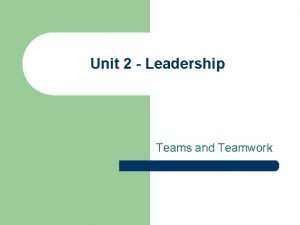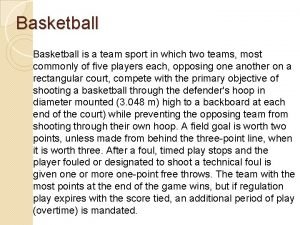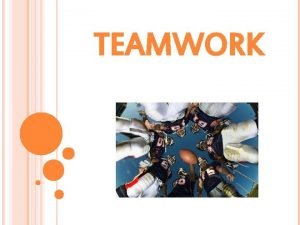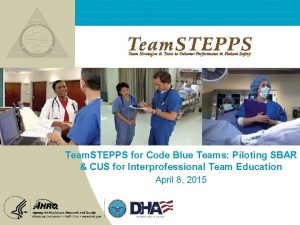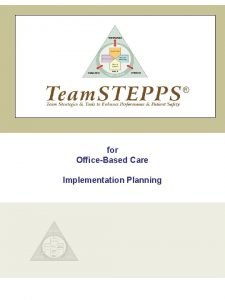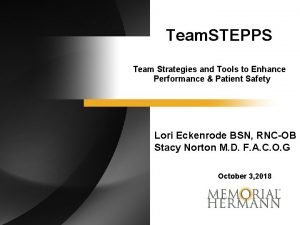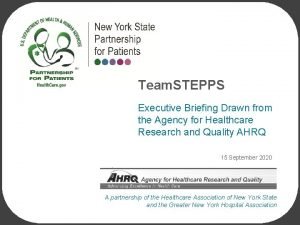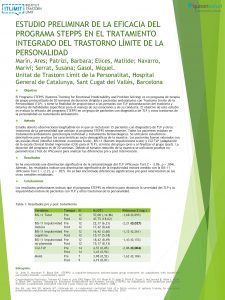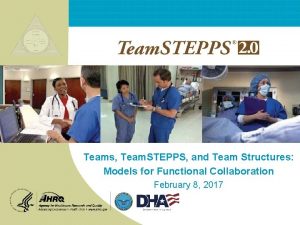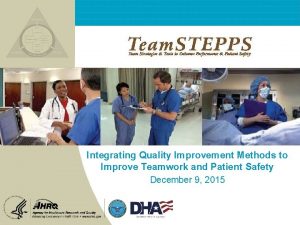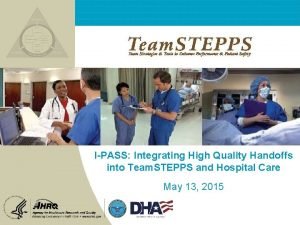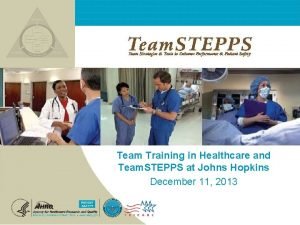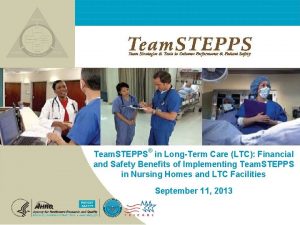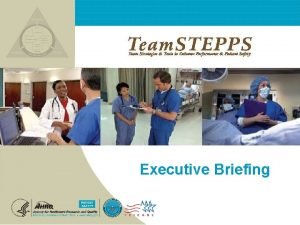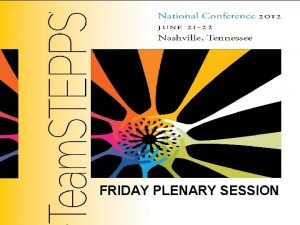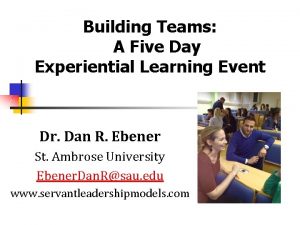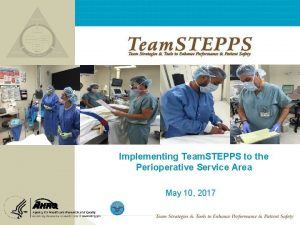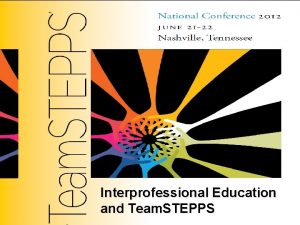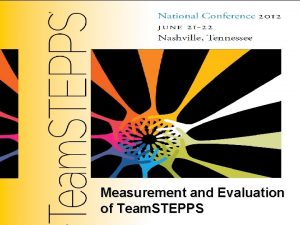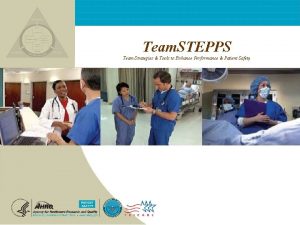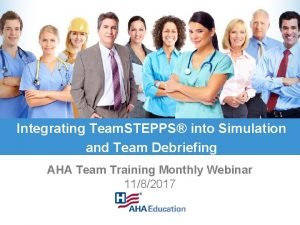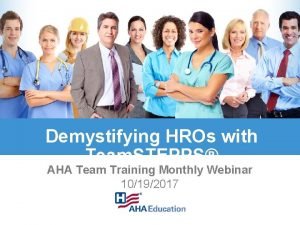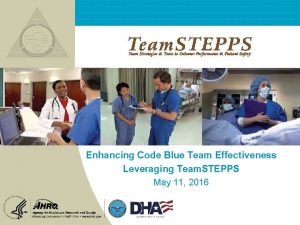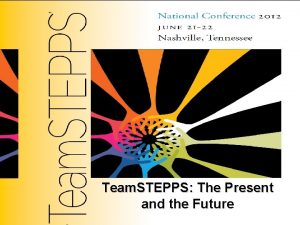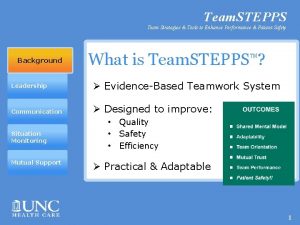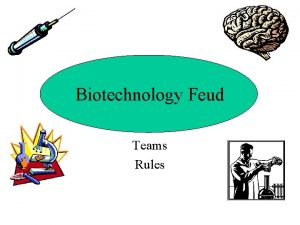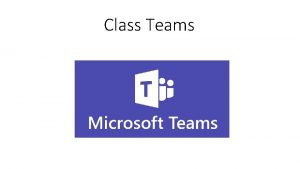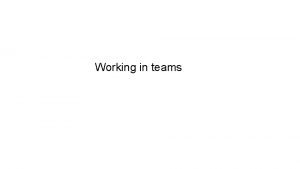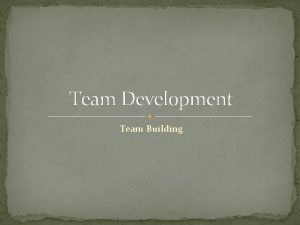Working in Teams Team STEPPS Lecture a This







![Leadership: Team Events Leadership: Team events [Screenshot]. Agency for Healthcare Research and Quality (2016). Leadership: Team Events Leadership: Team events [Screenshot]. Agency for Healthcare Research and Quality (2016).](https://slidetodoc.com/presentation_image/10a1e98d5bdc49b69d9f3bf2d27f7f14/image-8.jpg)
![Leadership: Brief Checklist Leadership: Brief checklist [Screenshot]. Agency for Healthcare Research and Quality (2016). Leadership: Brief Checklist Leadership: Brief checklist [Screenshot]. Agency for Healthcare Research and Quality (2016).](https://slidetodoc.com/presentation_image/10a1e98d5bdc49b69d9f3bf2d27f7f14/image-9.jpg)
![Leadership: Debrief Checklist Leadership: Debrief checklist [Screenshot]. Agency for Healthcare Research and Quality (2016). Leadership: Debrief Checklist Leadership: Debrief checklist [Screenshot]. Agency for Healthcare Research and Quality (2016).](https://slidetodoc.com/presentation_image/10a1e98d5bdc49b69d9f3bf2d27f7f14/image-10.jpg)
![Situation Monitoring Situation monitoring process [Screenshot]. Agency for Healthcare Research and Quality (2016). 11 Situation Monitoring Situation monitoring process [Screenshot]. Agency for Healthcare Research and Quality (2016). 11](https://slidetodoc.com/presentation_image/10a1e98d5bdc49b69d9f3bf2d27f7f14/image-11.jpg)
![Mutual Support Mutual support: Task assistance [Screenshot]. Agency for Healthcare Research and Quality (2016). Mutual Support Mutual support: Task assistance [Screenshot]. Agency for Healthcare Research and Quality (2016).](https://slidetodoc.com/presentation_image/10a1e98d5bdc49b69d9f3bf2d27f7f14/image-12.jpg)
![Mutual Support: DESC Script DESC script [Screenshot]. Agency for Healthcare Research and Quality (2016). Mutual Support: DESC Script DESC script [Screenshot]. Agency for Healthcare Research and Quality (2016).](https://slidetodoc.com/presentation_image/10a1e98d5bdc49b69d9f3bf2d27f7f14/image-13.jpg)



![Communication: Feedback [Screenshot]. Agency for Healthcare Research and Quality (2016). 17 Communication: Feedback [Screenshot]. Agency for Healthcare Research and Quality (2016). 17](https://slidetodoc.com/presentation_image/10a1e98d5bdc49b69d9f3bf2d27f7f14/image-17.jpg)
![Putting it Together and Measuring with Team. STEPPS Tape measure [Online image]. Courtesy of Putting it Together and Measuring with Team. STEPPS Tape measure [Online image]. Courtesy of](https://slidetodoc.com/presentation_image/10a1e98d5bdc49b69d9f3bf2d27f7f14/image-18.jpg)








- Slides: 26

Working in Teams Team. STEPPS Lecture a This material (Comp 17 Unit 11) was developed by Johns Hopkins University, funded by the Department of Health and Human Services, Office of the National Coordinator for Health Information Technology under Award Number IU 24 OC 000013. This material was updated in 2016 by Johns Hopkins University under Award Number 90 WT 0005. This work is licensed under the Creative Commons Attribution-Non. Commercial-Share. Alike 4. 0 International License. To view a copy of this license, visit http: //creativecommons. org/licenses/by-nc-sa/4. 0/.

Team. STEPPS Learning Objectives — Lecture a • Describe what Team. STEPPS is and how it can be used as an actionable improvement strategy. • Identify areas of application for Team. STEPPS tools and methods to be used in HIT teaming. • Integrate the science of team performance and team training. 2

Team. STEPPS Logo 11. 1 Figure. Agency for Healthcare Research and Quality (2016). 3

Team. STEPPS: http: //www. teamsteppsportal. org/ 11. 2 Figure. Team. STEPPS National Implementation and Agency for Healthcare Research and Quality (2016). 4

Core Principles 11. 3 Figure. Courtesy of Johns Hopkins University. 5

Team. STEPPS: Team Structure 11. 4 Figure. Courtesy of Johns Hopkins University. Adapted from the Agency for Healthcare Research and Quality, Team. STEPPS at http: //www. teamsteppsportal. org/. 6

Multi-Team Structure (MTS) 11. 5 Figure. Agency for Healthcare Research and Quality (2016). 7
![Leadership Team Events Leadership Team events Screenshot Agency for Healthcare Research and Quality 2016 Leadership: Team Events Leadership: Team events [Screenshot]. Agency for Healthcare Research and Quality (2016).](https://slidetodoc.com/presentation_image/10a1e98d5bdc49b69d9f3bf2d27f7f14/image-8.jpg)
Leadership: Team Events Leadership: Team events [Screenshot]. Agency for Healthcare Research and Quality (2016). 8
![Leadership Brief Checklist Leadership Brief checklist Screenshot Agency for Healthcare Research and Quality 2016 Leadership: Brief Checklist Leadership: Brief checklist [Screenshot]. Agency for Healthcare Research and Quality (2016).](https://slidetodoc.com/presentation_image/10a1e98d5bdc49b69d9f3bf2d27f7f14/image-9.jpg)
Leadership: Brief Checklist Leadership: Brief checklist [Screenshot]. Agency for Healthcare Research and Quality (2016). 9
![Leadership Debrief Checklist Leadership Debrief checklist Screenshot Agency for Healthcare Research and Quality 2016 Leadership: Debrief Checklist Leadership: Debrief checklist [Screenshot]. Agency for Healthcare Research and Quality (2016).](https://slidetodoc.com/presentation_image/10a1e98d5bdc49b69d9f3bf2d27f7f14/image-10.jpg)
Leadership: Debrief Checklist Leadership: Debrief checklist [Screenshot]. Agency for Healthcare Research and Quality (2016). 10
![Situation Monitoring Situation monitoring process Screenshot Agency for Healthcare Research and Quality 2016 11 Situation Monitoring Situation monitoring process [Screenshot]. Agency for Healthcare Research and Quality (2016). 11](https://slidetodoc.com/presentation_image/10a1e98d5bdc49b69d9f3bf2d27f7f14/image-11.jpg)
Situation Monitoring Situation monitoring process [Screenshot]. Agency for Healthcare Research and Quality (2016). 11
![Mutual Support Mutual support Task assistance Screenshot Agency for Healthcare Research and Quality 2016 Mutual Support Mutual support: Task assistance [Screenshot]. Agency for Healthcare Research and Quality (2016).](https://slidetodoc.com/presentation_image/10a1e98d5bdc49b69d9f3bf2d27f7f14/image-12.jpg)
Mutual Support Mutual support: Task assistance [Screenshot]. Agency for Healthcare Research and Quality (2016). 11. 6 Figure. 12
![Mutual Support DESC Script DESC script Screenshot Agency for Healthcare Research and Quality 2016 Mutual Support: DESC Script DESC script [Screenshot]. Agency for Healthcare Research and Quality (2016).](https://slidetodoc.com/presentation_image/10a1e98d5bdc49b69d9f3bf2d27f7f14/image-13.jpg)
Mutual Support: DESC Script DESC script [Screenshot]. Agency for Healthcare Research and Quality (2016). 13

Team. STEPPS: Communication • Coordinating mechanism. • Interplays with other elements. • Provides guidance. • Communication engenders culture of mutual support. Health care provider on the telephone [Online image]. 14 Agency for Healthcare Research and Quality.

Communication Techniques — 1 • SBAR: • Call-outs: – Situation. – Closed loop. – Background. – Communication – Assessment. during a critical event. – Directed to a specific individual. – Recommendation. 15

Communication Techniques — 2 • Check-back: – Closed loop. – “Did I hear what I thought you said? ” – Repeating to assure quality communication. • Handoff: goal is to assure a smooth transition of patient, information, plans, materials, etc. – Responsibility. – Accountability. – Uncertainty. – Communicate verbally. – Acknowledged. – Opportunity. 16
![Communication Feedback Screenshot Agency for Healthcare Research and Quality 2016 17 Communication: Feedback [Screenshot]. Agency for Healthcare Research and Quality (2016). 17](https://slidetodoc.com/presentation_image/10a1e98d5bdc49b69d9f3bf2d27f7f14/image-17.jpg)
Communication: Feedback [Screenshot]. Agency for Healthcare Research and Quality (2016). 17
![Putting it Together and Measuring with Team STEPPS Tape measure Online image Courtesy of Putting it Together and Measuring with Team. STEPPS Tape measure [Online image]. Courtesy of](https://slidetodoc.com/presentation_image/10a1e98d5bdc49b69d9f3bf2d27f7f14/image-18.jpg)
Putting it Together and Measuring with Team. STEPPS Tape measure [Online image]. Courtesy of Sarahluv’s Photostream. CC BY-NC-ND 2. 0. Team Performance Observation Tool [Screenshot]. Agency for Healthcare Research and Quality (2016). 18

Team. STEPPS as a Three-Phase Project 11. 7 Figure. Agency for Healthcare Research and Quality (2016). 19

Team. STEPPS Summary — Lecture a • Describe what Team. STEPPS is and how it can be used as an actionable improvement strategy. • Identify areas of application for Team. STEPPS tools and methods to be used in HIT teaming. • Integrate the science of team performance and team training. 20

Team. STEPPS References — Lecture a — 1 References Agency for Healthcare Research and Quality. (2016 March). Team. STEPPS®: Strategies and Tools to Enhance Performance and Patient Safety. Rockville, MD: Author. Retrieved April 18, 2016, from http: //www. ahrq. gov/professionals/education/curriculum-tools/teamstepps/index. html Charts, Tables, Figures 11. 1 Figure: Team. STEPPS logo. Agency for Healthcare Research and Quality. (2016 March). Team. STEPPS®: Strategies and Tools to Enhance Performance and Patient Safety. Rockville, MD: Author. Retrieved April 18, 2016, from http: //www. ahrq. gov/sites/default/files/wysiwyg/professionals/education/curriculumtools/teamstepps/instructor/fundamentals/module 1/slintro. pptx 11. 2 Figure: Team. STEPPS logo, “National Implementation” from http: //www. teamsteppsportal. org/. Agency for Healthcare Research and Quality logo. (2016 March). From: http: //www. ahrq. gov/sites/default/files/wysiwyg/professionals/education/curriculumtools/teamstepps/instructor/fundamentals/module 1/slintro. pptx 21

Team. STEPPS References — Lecture a — 2 Charts, Tables, Figures 11. 3 Figure: Mindful team. Johns Hopkins University staff. (2012). 11. 4 Figure: Team members. Johns Hopkins University staff. (2012). Adapted from the Agency for Healthcare Research and Quality. Team. STEPPS. http: //www. ahrq. gov/professionals/education/curriculum-tools/teamstepps/index. html 11. 5 Figure: Multi-team structure (MTS). Agency for Healthcare Research and Quality. (2016 March). Team. STEPPS®: Strategies and Tools to Enhance Performance and Patient Safety. Rockville, MD: Author. Retrieved April 18, 2016, from http: //www. ahrq. gov/sites/default/files/wysiwyg/professionals/education/curriculumtools/teamstepps/instructor/fundamentals/module 2/slteamstructure. pptx 11. 6 Figure: Team structure cycle. Johns Hopkins University staff. (2012). 11. 7 Figure: Shift towards a culture of safety. Agency for Healthcare Research and Quality. (2016 March). Team. STEPPS®: Strategies and Tools to Enhance Performance and Patient Safety. Rockville, MD: Author. Retrieved April 18, 2016, from http: //www. ahrq. gov/sites/default/files/wysiwyg/professionals/education/curriculumtools/teamstepps/instructor/fundamentals/module 1/slintro. pptx 22

Team. STEPPS References — Lecture a — 3 Images Slide 8: Leadership: Team events [Screenshot]. Agency for Healthcare Research and Quality. (2016). Classroom slides. Team. STEPPS® essentials instructional module and course slides. Retrieved April 20, 2016, from http: //www. ahrq. gov/sites/default/files/wysiwyg/professionals/education/curriculumtools/teamstepps/instructor/essentials/slessentials. pptx Slide 9: Brief checklist [Screenshot]. Agency for Healthcare Research and Quality. (2016). Classroom slides. Team. STEPPS® essentials instructional module and course slides. Retrieved April 20, 2016, from http: //www. ahrq. gov/sites/default/files/wysiwyg/professionals/education/curriculumtools/teamstepps/instructor/essentials/slessentials. pptx Slide 10: Leadership: Debrief checklist [Screenshot]. Agency for Healthcare Research and Quality. (2016). Classroom slides. Team. STEPPS® essentials instructional module and course slides. Retrieved April 20, 2016, from http: //www. ahrq. gov/sites/default/files/wysiwyg/professionals/education/curriculumtools/teamstepps/instructor/essentials/slessentials. pptx 23

Team. STEPPS References — Lecture a — 4 Images Slide 11: Situation monitoring process [Screenshot]. Agency for Healthcare Research and Quality. (2016). Classroom slides. Team. STEPPS® essentials instructional module and course slides. Retrieved April 20, 2016, from http: //www. ahrq. gov/sites/default/files/wysiwyg/professionals/education/curriculumtools/teamstepps/instructor/essentials/slessentials. pptx Slide 12: Mutual support: Task assistance [Screenshot]. Agency for Healthcare Research and Quality. (2016). Classroom slides. Team. STEPPS® essentials instructional module and course slides. Retrieved April 20, 2016, from http: //www. ahrq. gov/sites/default/files/wysiwyg/professionals/education/curriculumtools/teamstepps/instructor/essentials/slessentials. pptx Slide 13: DESC script [Screenshot]. Agency for Healthcare Research and Quality. (2016). Classroom slides. Team. STEPPS® essentials instructional module and course slides. Retrieved April 20, 2016, from http: //www. ahrq. gov/sites/default/files/wysiwyg/professionals/education/curriculumtools/teamstepps/instructor/essentials/slessentials. pptx 24

Team. STEPPS References — Lecture a — 5 Images Slide 14: Health care provider on the telephone [Online image]. Agency for Healthcare Research and Quality. (2016). Classroom slides. Team. STEPPS® essentials instructional module and course slides. Retrieved April 20, 2016, from http: //www. ahrq. gov/sites/default/files/wysiwyg/professionals/education/curriculumtools/teamstepps/instructor/essentials/slessentials. pptx Slide 17: Feedback [Screenshot]. Agency for Healthcare Research and Quality. (2016). Classroom slides. Team. STEPPS® essentials instructional module and course slides. Retrieved April 20, 2016, from http: //www. ahrq. gov/sites/default/files/wysiwyg/professionals/education/curriculumtools/teamstepps/instructor/essentials/slessentials. pptx Slide 18: Tape measure [Online image]. Image courtesy of Sarahluv's Photostream. CC BY-NC_ND 2. 0. Available from http: //www. flickr. com/photos/sarahluv/3803170987/ Slide 18: Team performance observation tool [Screenshot]. Agency for Healthcare Research and Quality. (2016). Pocket Guide: Team. STEPPS®. Retrieved April 20, 2016, from http: //www. ahrq. gov/professionals/education/curriculumtools/teamstepps/instructor/essentials/pocketguide. html 25

Working in Teams Team. STEPPS Lecture a This material (Comp 17 Unit 11) was developed by Johns Hopkins University, funded by the Department of Health and Human Services, Office of the National Coordinator for Health Information Technology under Award Number IU 24 OC 000013. This material was updated in 2016 by Johns Hopkins University under Award Number 90 WT 0005. 26
 Unit 2 teams working together
Unit 2 teams working together Leading and working in teams
Leading and working in teams Teamwork
Teamwork Basketball is a team sport in which two teams
Basketball is a team sport in which two teams Gatherer
Gatherer Teamstepps sbar
Teamstepps sbar Stepps program worksheets
Stepps program worksheets Stepps framework
Stepps framework I am safe checklist
I am safe checklist Stepps model
Stepps model Programa stepps
Programa stepps Stepps model
Stepps model Stepps model
Stepps model Stepps model
Stepps model Stepps training
Stepps training Teamstepps meaning
Teamstepps meaning Stepps model
Stepps model Stepps
Stepps 01:640:244 lecture notes - lecture 15: plat, idah, farad
01:640:244 lecture notes - lecture 15: plat, idah, farad Hot working and cold working difference
Hot working and cold working difference Differentiate between hot working and cold working
Differentiate between hot working and cold working Working smart vs working hard
Working smart vs working hard Proses pengerjaan logam
Proses pengerjaan logam Advantage of cold working
Advantage of cold working Acrostic poem of teamwork
Acrostic poem of teamwork Teams typically outperform individuals
Teams typically outperform individuals Team vs working group
Team vs working group
